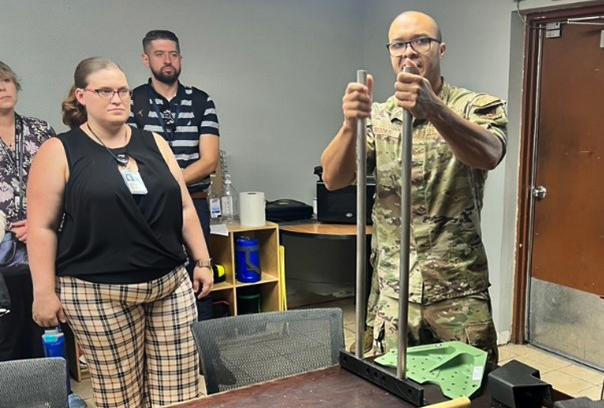WRIGHT-PATTERSON AIR FORCE BASE, Ohio – Junior members of the Air Force Research Laboratory, or AFRL, braved the summer heat to visit Luke Air Force Base and Arizona State University, or ASU, Aug. 8-11, 2023, for AFRL’s annual Bluing Trip.
Each year, AFRL’s Junior Force Council, or JFC, hosts exploratory excursions to operational Air Force bases to expose military and civilian Airmen to missions and organizations outside of the employees’ regular operational duties. Focused on building camaraderie, connecting colleagues and reinforcing and introducing a greater understanding of the JFC members’ role in the larger Air Force environment, these tours are critical to the success of AFRL.

U.S. Air Force Col. Joel Luker, fifth from right, deputy commander, Air Force Research Laboratory, or AFRL, and AFRL Junior Force Council members are pictured during the AFRL Junior Force Council Bluing Trip Aug. 8, 2023, at Luke Air Force Base, Ariz. The three-day bluing trip took place Aug. 8-11, 2023. The base hosted junior AFRL members from across the AFRL enterprise to expose members to the Air Force mission. (U.S. Air Force photo / Shannon Tighe)
“The Bluing Trip is designed for our Airmen and Civilians to get out of their labs or offices and see how other parts of the Air Force and AFRL truly support each other and our warfighters,” said Col. Joel Luker, AFRL Deputy Commander. “Our workforce is our advantage, and these base visits are crucial to build our Junior Force members’ understanding of how the Air Force works, the challenges faced every day not just by our warfighters, but also the thousands of maintainers, administrators and base operations personnel that make our Air Force run. The visits also help our newer members understand AFRL is not just a normal research institution, but a military organization delivering crucial capabilities required for the Department of the Air Force to be successful in today’s era of Great Power Competition.”
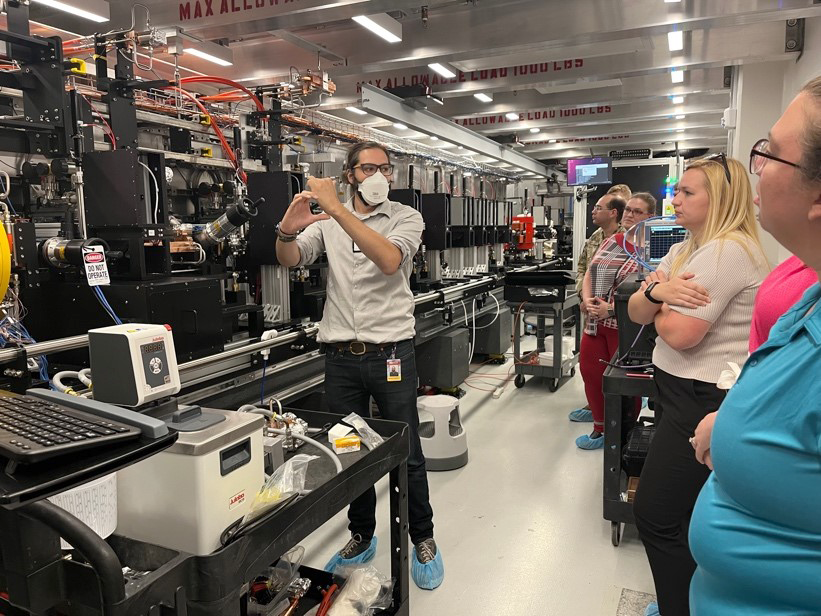
AFRL Bluing Trip reinforces community, connections collaboration in Phoenix
Dr. Samuel Teitelbaum, left, Arizona State University Assistant, or ASU, professor, shows Junior Force Council members the large-scale Compact X-Ray Free Electron Laser during a tour of ASU labs Aug. 10, 2023, part of the Air Force Research Laboratory JFC Bluing Trip at Luke Air Force Base, Ariz. In addition to touring the base to get an understanding of missions and organizations that support the Air Force, JFC members toured ASU to deepen their understanding of support and collaboration between industry and the DOD. (U.S. Air Force photo / Kiara Palmer)
Over the three days, JFC members toured and connected with Airmen from various departments across Luke Air Force Base, including the 56th Fighter Wing, the Aircrew Ground Equipment Unit and the Field Training Detachment. Members also found opportunities to chat with an Air Force pilot and get up close and personal with Air Force F-35s and F-16s.
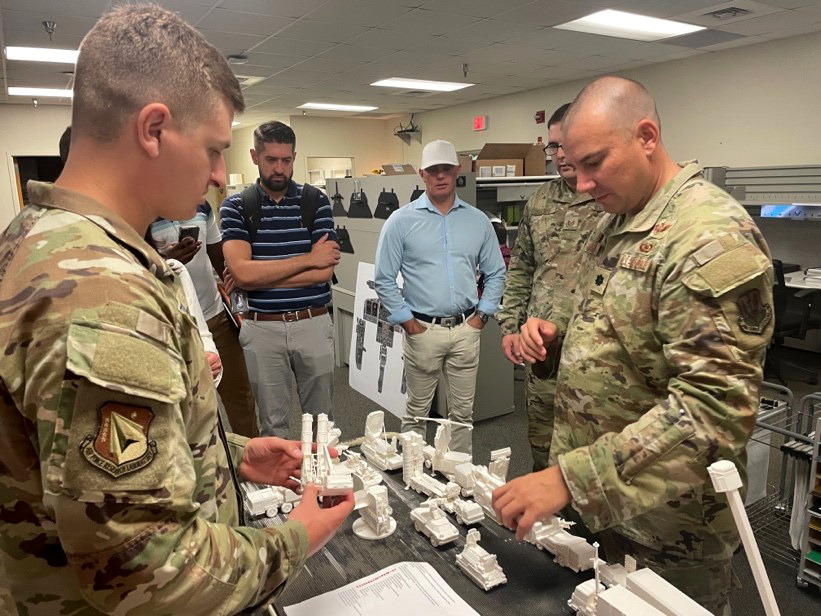
U.S. Air Force Lt. Col. Kyle Jansen, right, Detachment 9 commander, Air Combat Command Training Support Squadron explains how his unit uses 3D-printed models to support training efforts during a visit to an AFWERX facility Aug. 9, 2023, as part of the Air Force Research Laboratory, or AFRL, Junior Force Council Bluing Trip at Luke Air Force Base in Phoenix, Ariz. AFRL JFC Bluing Trips expose junior members of the AFRL workforce to technologies and people that support the Air Force mission. (U.S. Air Force photo / Kiara Palmer)
For AFRL researcher 1st Lt. Stephen Iurassich, the highlight of the visit was the base’s innovation unit, the Thunderbolt Spark Cell. Developed to foster ideas that accomplish and accelerate the Air Force mission, the Spark Cell allows Airmen to address and find solutions for short-term problems.
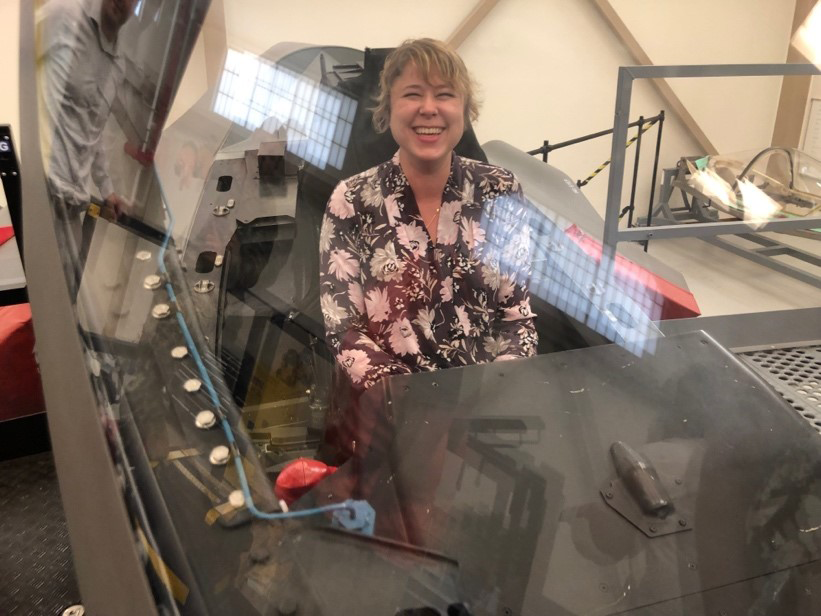
Dr. Jennie Burns, Junior Force Council, or JFC, member and research biomedical engineer for the 711th Human Performance Wing, smiles from the cockpit of an F-16 Falcon training model Aug. 8, 2023, as part of the three-day Air Force Research Laboratory, or AFRL, JFC Bluing Trip at Luke Air Force Base, Ariz. Each year, junior members of the AFRL workforce are exposed to missions and organizations outside of the employee’s regular operational duties to understand their role in the larger Air Force environment. (U.S. Air Force photo / Kiara Palmer)
“Learning that a tool was created, prototyped, developed and patented onsite to address an aircraft maintenance issue was impressive,” said Iurassich, AFRL Aerospace Systems Directorate engineer. “Because of my background as a maintenance engineer and acquisitions specialist, it was exciting to see a unit dedicated to finding and creating solutions and financial resources that addressed an issue internally and created a solution usable by the Air Force.”
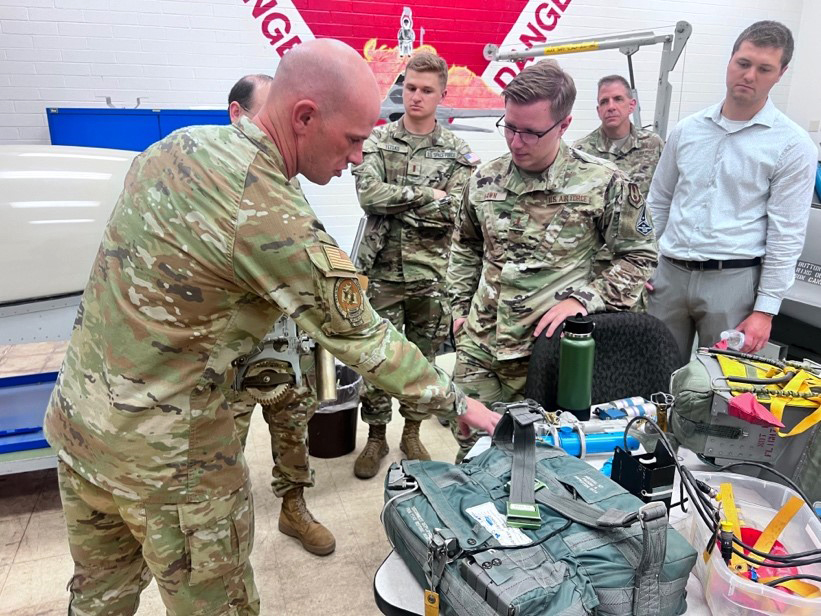
U.S. Air Force Tech. Sgt. Shawn Layou, left, Detachment 12 egress systems instructor, explains to Junior Force Council members, or JFC, the various materials and supplies included in pilot ejection kits Aug. 8, 2023, during a tour of the Field Training Detachment Unit, as part of the three-day Air Force Research Laboratory, or AFRL, JFC Bluing Trip at Luke Air Force Base, Ariz. AFRL JFC Bluing Trips expose junior members of the AFRL workforce to technologies and people that support the Air Force mission. (U.S. Air Force photo / Kiara Palmer)
While the Spark Center tour offered insight into base innovation, the tour provided organic avenues for collaborations. Dr. Taylor Curley, a research psychologist for the 711th Human Performance Wing or HPW, found that current Spark Cell projects overlapped with the 711 HPW research topics and thus an opportunity to share information and improve communications.
“One of my specialties is looking at analyses and developing metrics to follow human performance across long periods. Because of similar research and goals, I am gathering and sharing data as they build their project,” said Curley. “On one hand, it was amazing to see where I could plug in efforts to support their projects, but I also see an opportunity to improve communication between the Spark Cell and AFRL.”
While Luke AFB leverages the Spark Cell to help mitigate and improve short-term needs, the base partners with academia to help translate and build solutions for longer-term Air Force technologies and support.
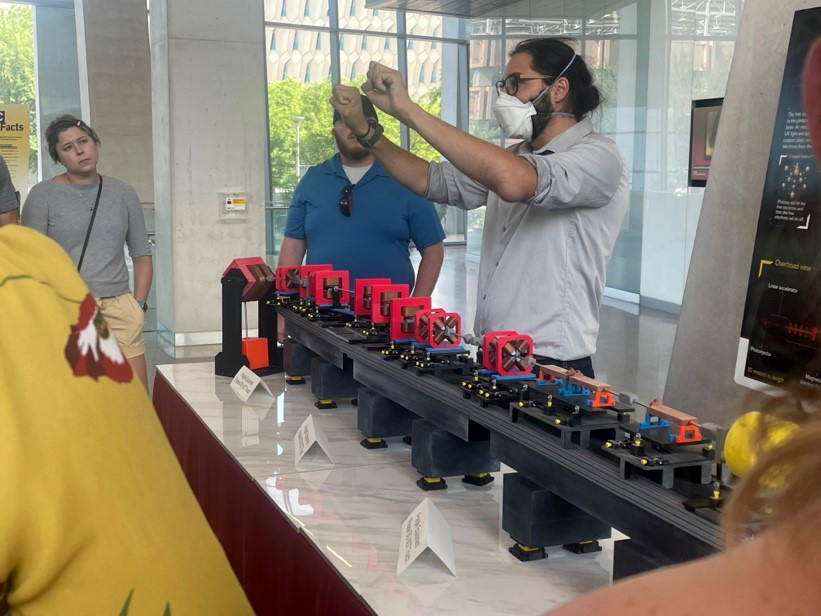
Dr. Samuel Teitelbaum, right, Arizona State University Assistant professor, demonstrates how light particles pass through a Compact X-Ray Free Electron Laser during a tour Aug. 10, 2023, part of the AFRL Junior Force Council Bluing Trip at Luke Air Force Base, Ariz. In addition to touring the base to get an understanding of missions and organizations that support the Air Force, JFC members toured ASU to deepen their understanding of support and collaboration between industry and the DOD. (U.S. Air Force photo / Kiara Palmer)
To gain an understanding of what that support and collaboration between industry and the DOD looks like, AFRL junior members spent a full day touring ASU’s Compact X-ray Free Electron Laser, Dreamscape Immersive Training Experience, Drone Studio and Macro Technology Works. Notably, attendees learned of the new ASU-DOD Masters of Innovation program being piloted in September 2023.
While the JFC Bluing Trip granted attendees many opportunities to learn and collaborate, it also allowed them to build connections and network with their own AFRL colleagues.
“We were all strangers on day one. Then by day three, it’s like we’ve known each other for years, sharing ideas and suggestions to improve our work,” said Sulejman Jasarbegovic, a contract specialist for AFRL’s Information Directorate. “I’m currently in talks with another JFC member from the Air Force Office of Scientific Research, who shared a new program to help improve our contracts and grants management processes.”

Dr. Katie Detwiler, research materials engineer for the Air Force Research Laboratory, or AFRL, Materials and Manufacturing Directorate, and Dr. Jennie Burns, research biomedical engineer for the 711th Human Performance Wing, examine tools developed at the Spark Cell Aug. 8, 2023, as part of the annual AFRL Junior Force Council Bluing Trip at Luke Air Force Base in Phoenix, Ariz. The three-day bluing trip took place Aug. 8-11, 2023. The base hosted junior AFRL members from across the AFRL enterprise to expose members to the Air Force mission. (U.S. Air Force photo / Kiara Palmer)
With the range of tours and countless opportunities to connect and collaborate, AFRL JFC members urged others to participate in future Bluing Trips to support their professional development and further the efforts of the Air Force.
“It’s important that we get out of our office and labs and look at what Airmen are doing and what they need, so we can tailor our activities to support them and the mission,” said Curley.
For more information about the AFRL JFC and how to participate in future bluing trips, please contact the JFC Executive Board at AFRL.JFC.Corp.Board@us.af.mil.
About AFRL
The Air Force Research Laboratory is the primary scientific research and development center for the Department of the Air Force. AFRL plays an integral role in leading the discovery, development, and integration of affordable warfighting technologies for our air, space, and cyberspace forces. With a workforce of more than 11,500 across nine technology areas and 40 other operations across the globe, AFRL provides a diverse portfolio of science and technology ranging from fundamental to advanced research and technology development. For more information, visit www.afresearchlab.com.
About JFC
The Air Force Research Laboratory Junior Force Council, or JFC, is the leading professional development and networking resource group aimed to support all “junior” AFRL military and civilian members. Understanding the unique and critical role the junior workforce plays, AFRL recognizes that providing experiences for our junior workforce to access, creates a sense of purpose while they gain a better understanding of how their jobs matter, and is critical to the retention of these “junior” members.

